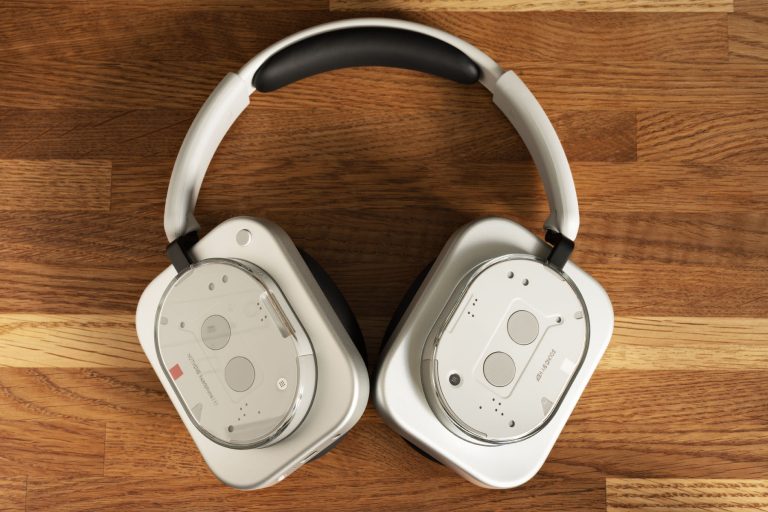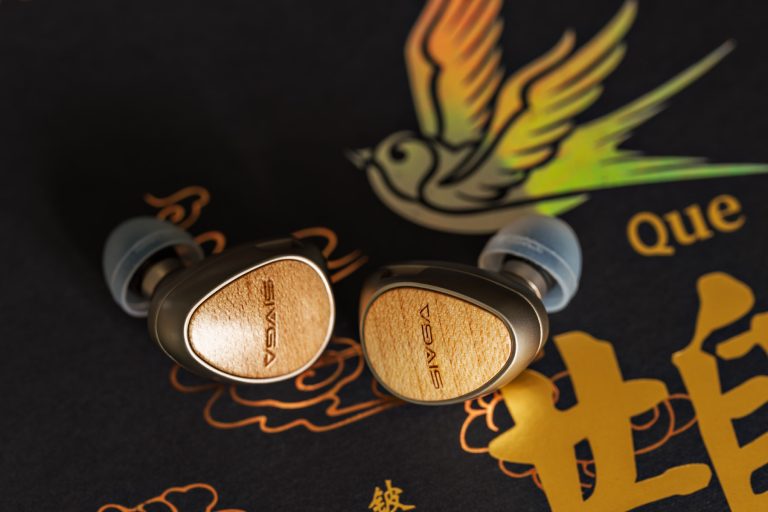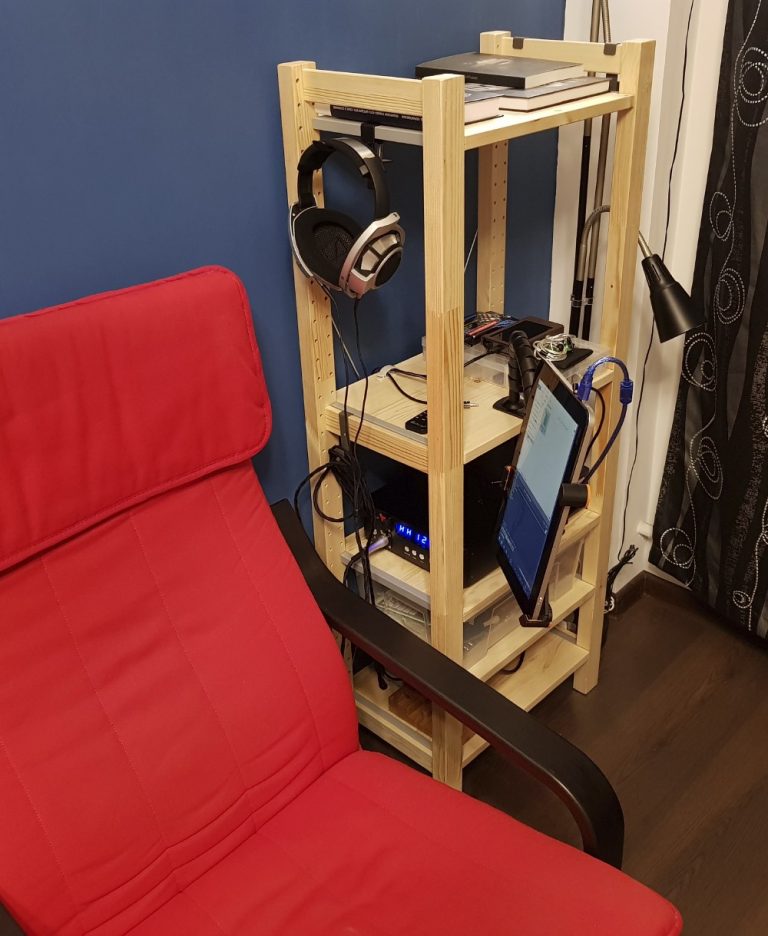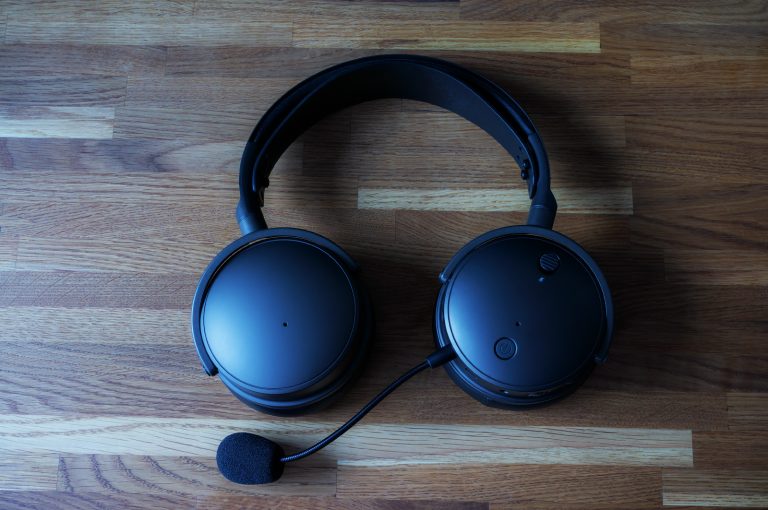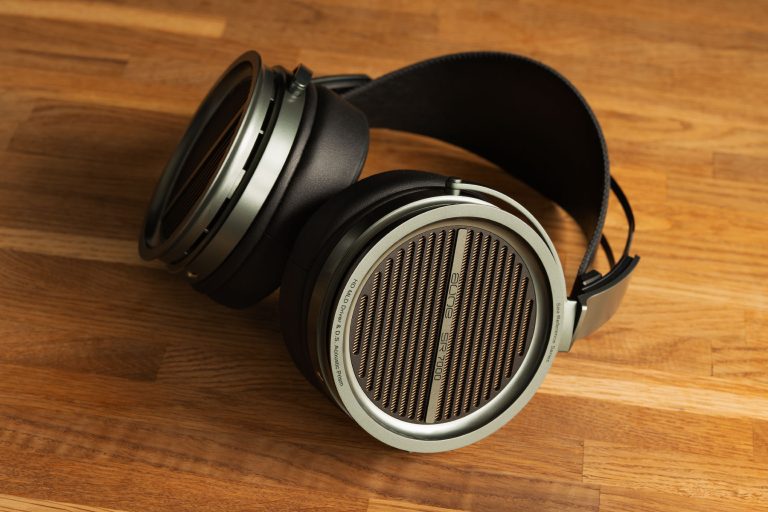Anker Soundcore Liberty 3 Pro: Chicken Drumsticks In The Headphones Universe
I’ve been planning to lay my hands on these headphones for a very long time now. Other reviewers say they’re like ‘the new TWS’s benchmark’ and ‘the end of Sony’s monopoly’ and stuff, so why wouldn’t I want to review those myself! So I was working round and round these headphones, and then a follower of mine unexpectedly offered me their pair to use for a review. Like, to send them to my place. So I can make a review.
I agreed before that kind person could generate any second thoughts.
So, here they are: the TWS Anker Soundcore Liberty 3 Pro headphones (hereinafter – ASLP3).
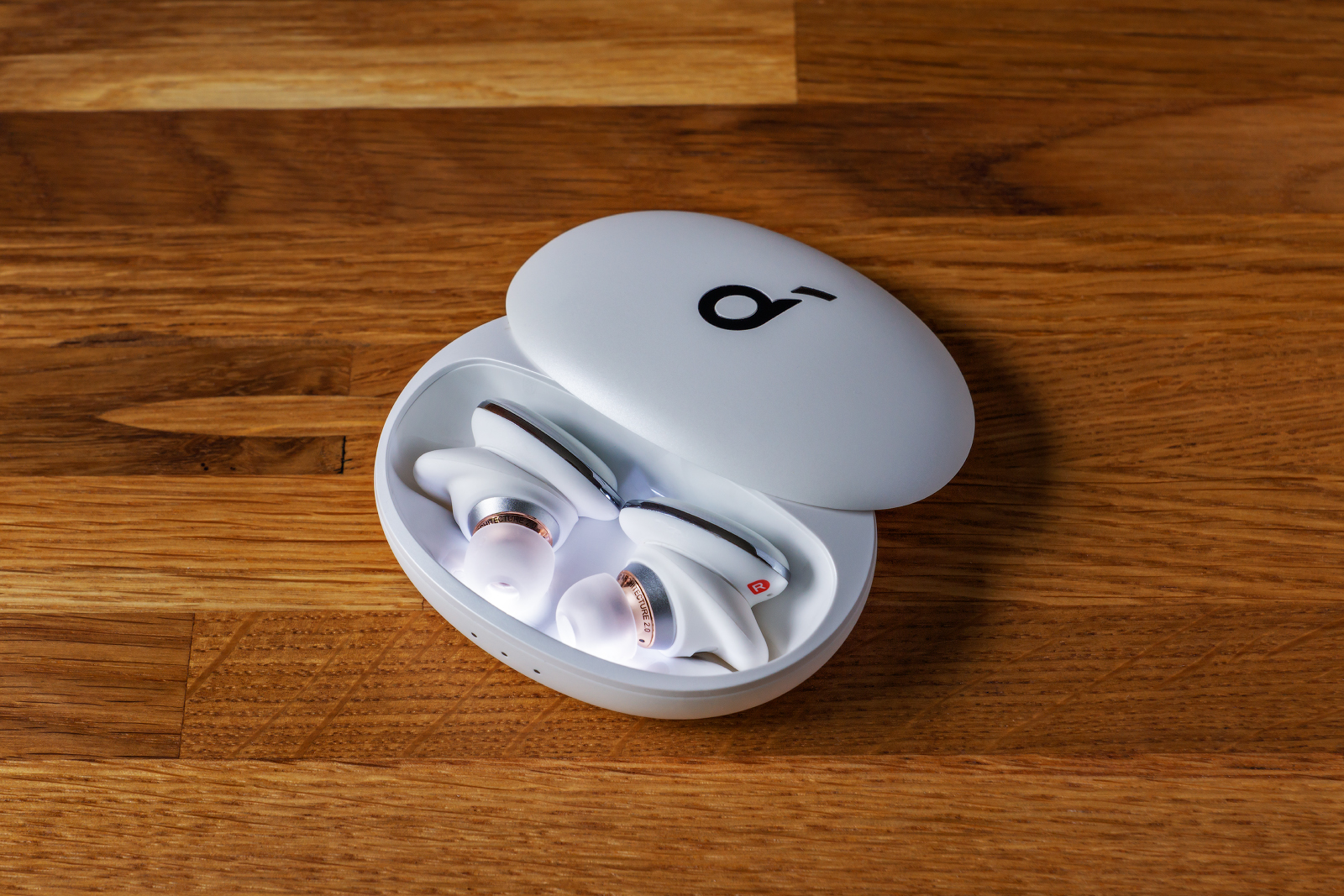
What’s included
Well, the kit looks like a New Year present box with the main present, a ton of sweets and a couple of tangerines: besides the headphones themselves, a case and a cable, there are also 4 pairs of eartips and 4 pairs of different earwings to keep them in place.

The box is beautiful, too: it’s made of thick cardboard with a magnetic snap.
Design, build quality, comfort level
Don’t expect the case lid to open in a perfectly normal way. You should slide it up instead. The case itself has a very smooth finish, so when trying to open it while holding it with one hand, there’s a pretty high chance to drop the bastard on the floor. What I’m trying to say, this isn’t the most ergonomic design, that’s it. When the thing is finally open, there are the built-in LEDs to welcome you inside. These are here to help you quickly find the headphones. Thank you, guys: now I can do it without my dedicated pocket light. The magnetic fasteners hold the headphones securely in their places, so there’s no way to throw the earpieces in the case without aligning the charging contacts. What a nice feature, right, Momentum True Wireless?
The case can be charged via USB Type-C, wireless charging is here. There’s a headphone reset button on the backside, three LEDs on the front to indicate the charge level – the battery is built into the case. The headphones are assembled just superbly, they’re like two solid pieces – no notches, no joint seams visible.
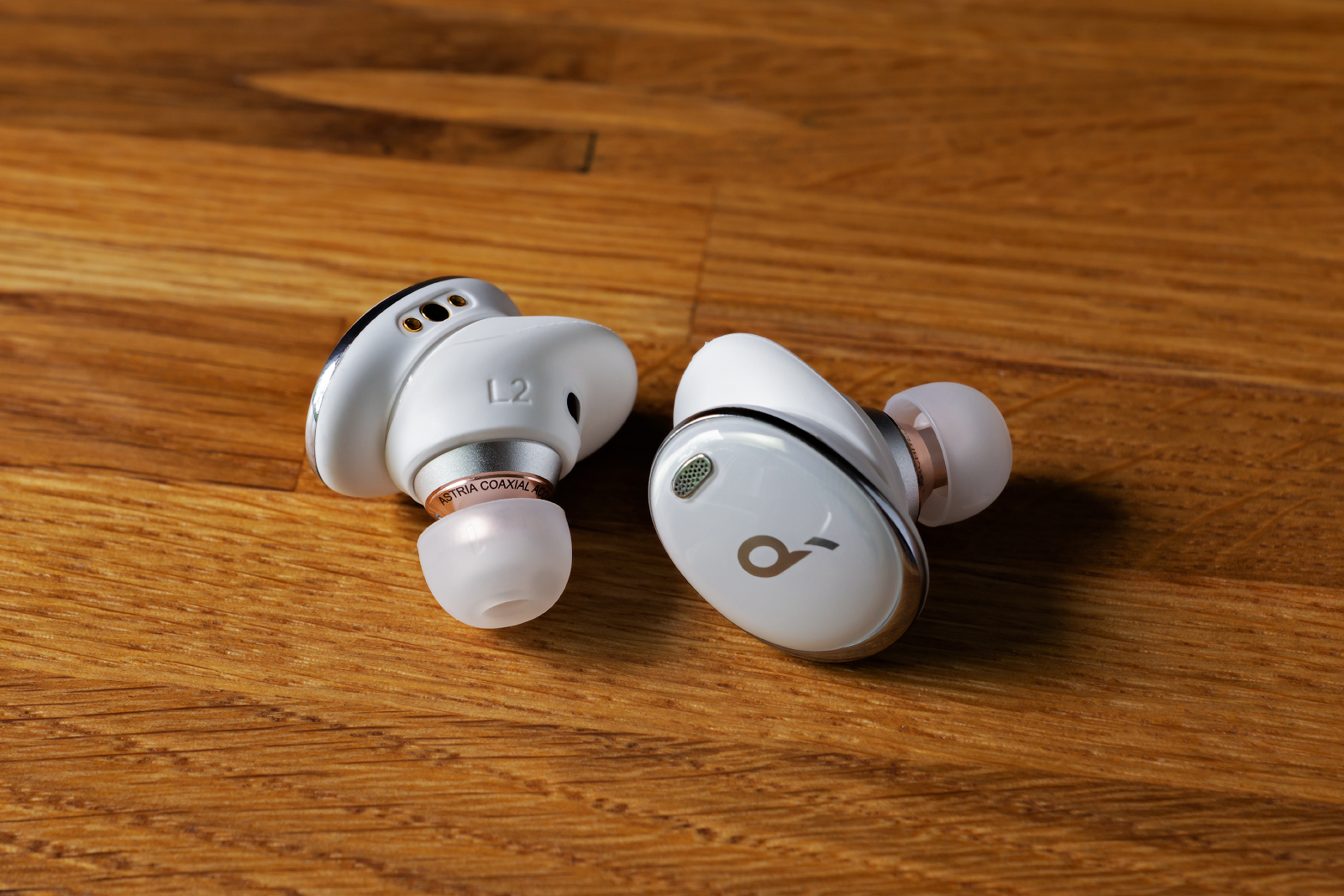
The sound ducts have two grids atop. What’s their function? Looks good, anyway.
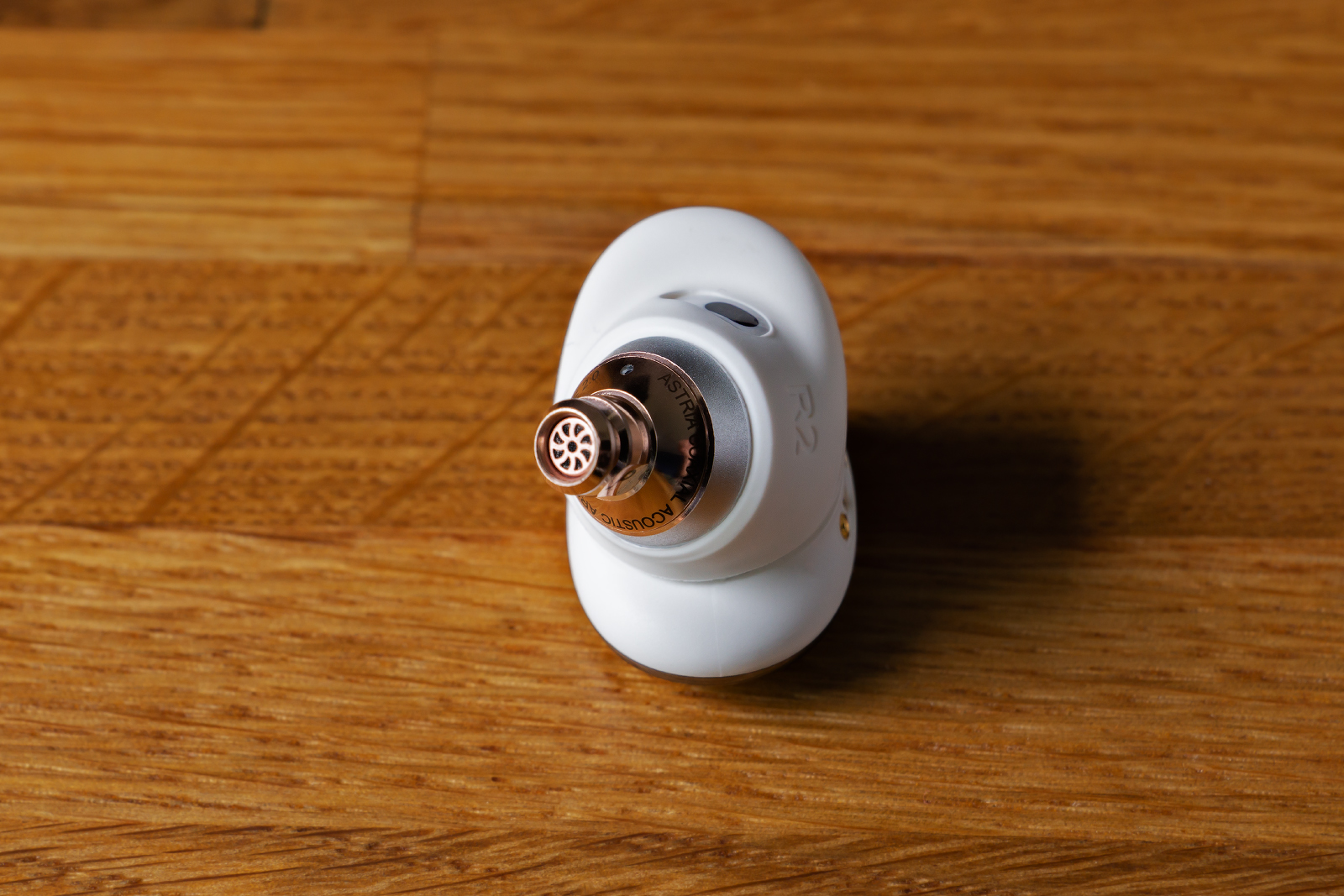
The eartips provided have special seals to prevent slipping off the sound ducts.
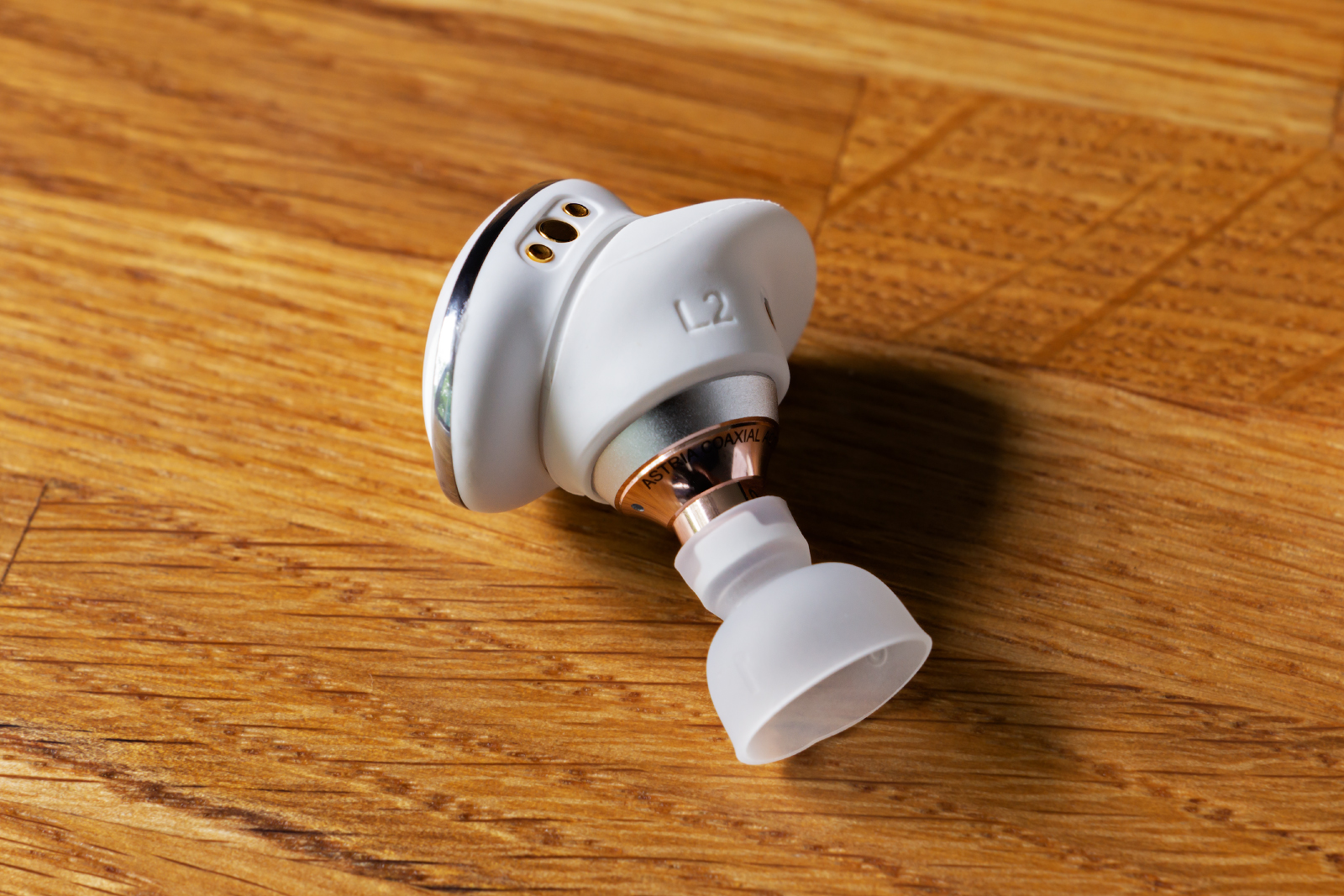
I’d say that the eartips are good, since they provide nice sound isolation and don’t try to crawl out of your ears (at least not willingly). Just so you know, the diameter and the design of the sound ducts allow you to use any third-party eartips. I’ve tried the Spiraldots and the SpinFit – both fit and hold on just awesome.
The headphones are designed all fancy: these are made to be noticed (and admired). I’d recommend the manufacturer to add some LEDs onto the headphones, so that everyone can see exactly what’s in your ears and faint out of pure envy.
Alright, now we know the design is somewhat controversial, but the ergonomics is one of the strongest points of the model. Due to the large selection of the eartip sizes and additional attachments (hollow from the inside, and therefore very soft), the ASLP3 can be fit in almost any ears – of almost any size or shape. Moreover, you’ll barely feel them inside, and won’t lose even during a very intense evening run (from your neighbor’s dog). I’m actually ready to admit that in terms of comfort, the ASLP3 may be the most comfortable, firm and versatile TWS headphones (of all times) that I had a chance to use.
For control, there are touch panels on the outer surfaces of the earpieces. These areas are quite large, so you just hit them with your fingers every single time without fail, and the touches themselves are interpreted correctly. Don’t know what else I can say. It’s just cool.
Each of the earpieces has a sensor to determine whether they’re in your ears or not to automatically interrupt playback when removed. The feature actually works, although with some delay. Bad news: the playback doesn’t resume when you put the earpiece back in your ear. You’d probably want to stop being polite and remove the headphones when someone wants to address you.
Technical specs
- Design: in-ear closed-back.
- Drivers: 1 dynamic + 1 armature.
- Supported codecs: LDAC, AAC, SBC.
- Active Noise Canceling (ANC): yes.
- Battery life: 8 hours without ANC, 6.5 hours with ANC. The case has a battery capacity worth of 3 full charges.
- Water resistance: IPX4.
Measurements and sound without equalization
The headphones were used with the Hiby R5 player (LDAC). A measuring rig conforms to the IEC60318-4 standard. For each of the earpieces, the measurements were made until 3 reliable and stable measurements were obtained for the left and right channels; any deviant measurement results were excluded. The provided earpads were used for measurements. The smoothing is indicated on the graphs. As always, for the info about rigs, graphs and headphones measurements refer to my article.
The ASLP3 frequency response with noise canceling turned off and on:
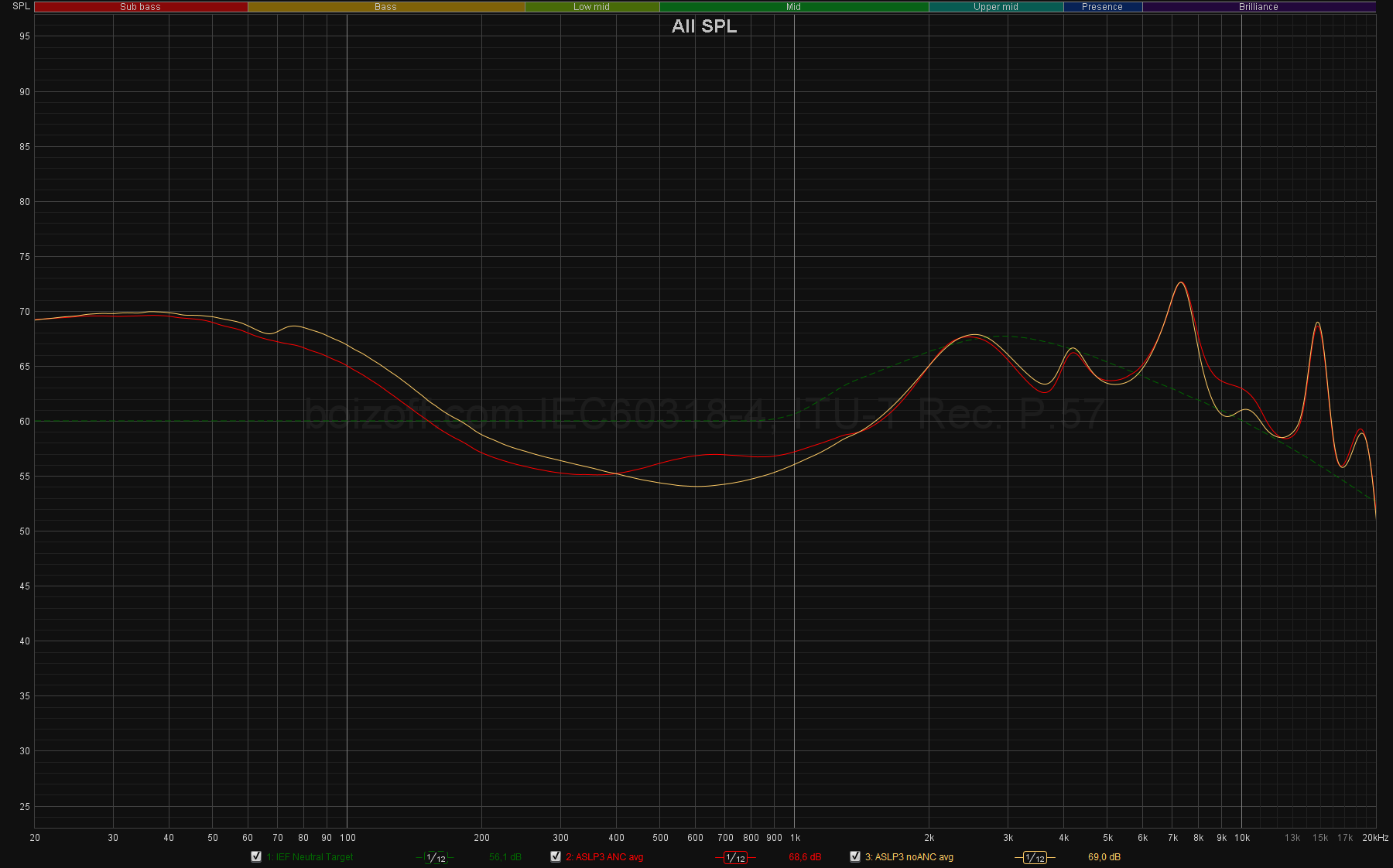
I don’t really know which shape – U, V or W – would denote such a tuning, but the words ‘monstrous’, ‘gigantic’ and ‘wildest’ are the most appropriate here:
- the monstrous rise in bass and subbass: the difference at frequencies of 60 and 400 Hz is of 16 dB;
- that giant midrange dip with a minimum at 400 Hz;
- the wildest peak at 7.2 kHz.
That is, the tuning is even more bassy and bright at the same time than the Harman standard, not to mention the IEF curve:
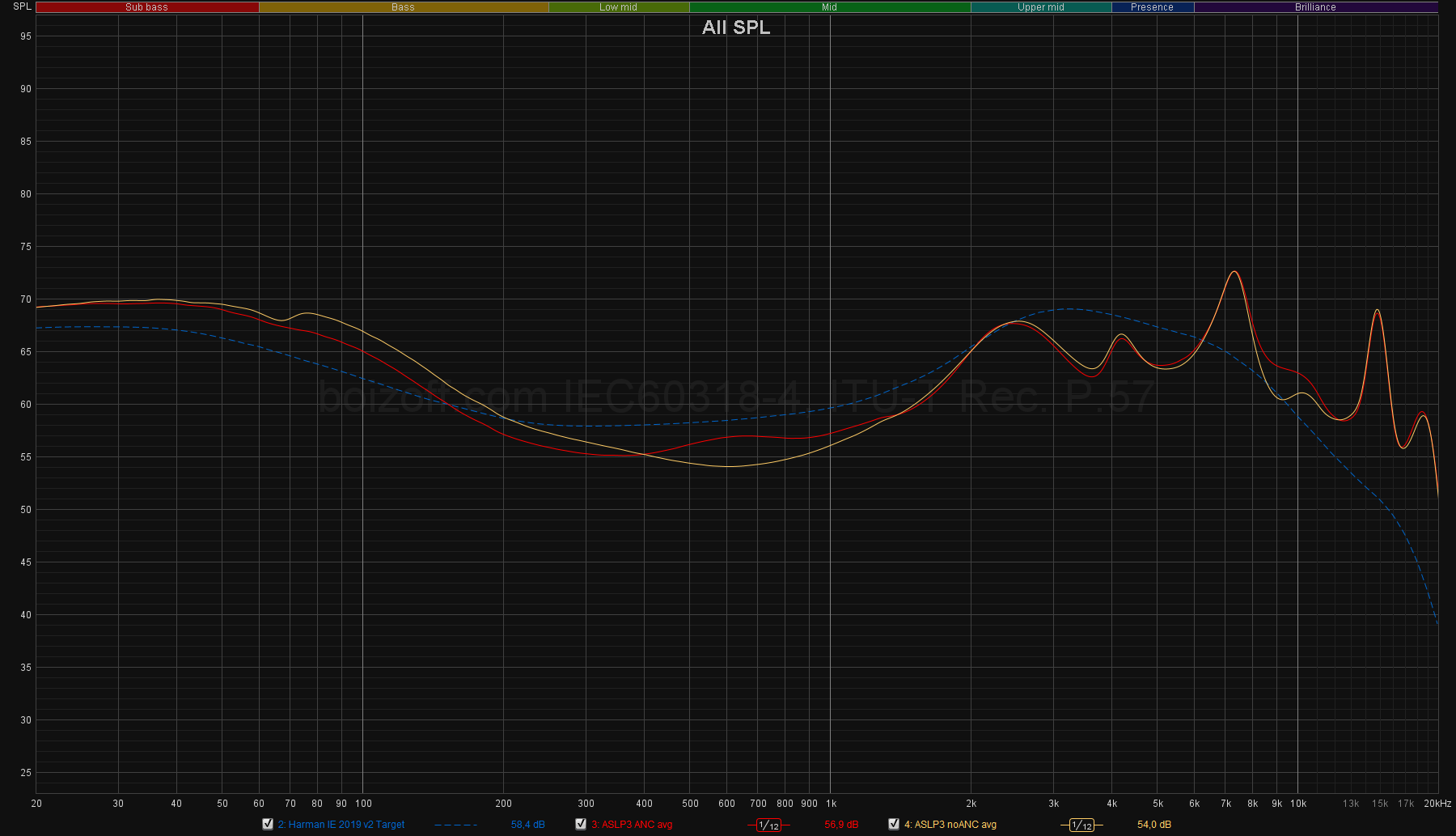
Measurements and sound after equalization
The proprietary app equalizer will help you achieve a significantly more balanced sound delivery.
For the noise canceling mode: here are the equalizer settings and measurements after the equalization applied:
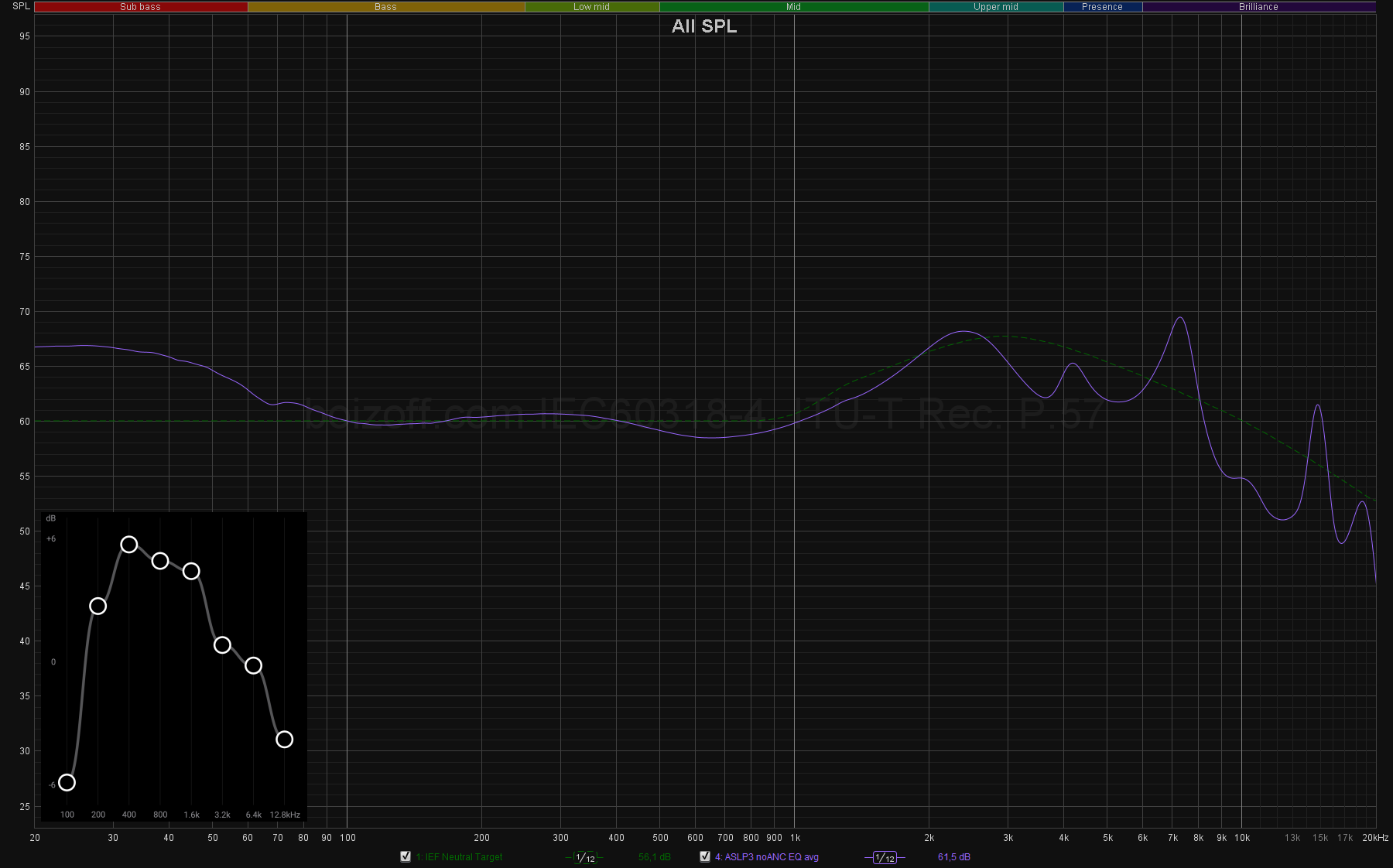
It turned out to be significantly smoother, but not over the entire range:
- the subbass is still kind of inflated at 6 dB at the peak;
- the 7.2 kHz section sticks out, but not too much.
Similarly, you can adjust the sound with the noise canceling enabled:

The tuning looks about the same as without noise canceling, but the section around 10 kHz doesn’t droop that much.
Sound delivery as I see it
In the absence of equalization, the ASLP3 sound disgusting without any ‘buts’. Remember when an airplane takes off, and your ears get clogged, and the only thing you hear is an ultra-low-frequency hum and a sharp high-frequency ringing. Well, if you can’t go on vacation, grab the ASLP3 to get that airplane ambience. On the Anker website, they say that the ASLP3 are ‘recommended by 20 Grammy winning audio producers’.
If it’s true, I feel very sorry for the Grammy. Who are these 20 experts, anyway? Does the Grammy management know who they’re dealing with? Should we warn their partnership managers?
When applying the above equalizer parameters, the sound delivery changes radically. It’s not just a ‘quite pleasant sound signature’ anymore, but a very, very ‘tasty’, but still balanced sound delivery:
- See? The subbass is clearly highlighted here. I’d note that such ultra-low frequencies are only obtained if the eartip fits perfectly to the walls of the ‘auditory canal’ of the rig, that is, this rise will be less pronounced in real life.
- The 100 to 1000 Hz range is mostly smooth with deviations of +/-1 dB – and all frequencies are heard equally well. A small hump at 2.7 kHz adds clarity to the sound, bringing it closer to the listener.
- The accent around 6–8 kHz is quite smooth (though I suspect that the rig is kind of glitching, and the peak isn’t really that high), so the headphones don’t flatten the nearby frequency sections – only add sharpness to the sound of cymbals, the ringing of strings, and stuff. The sibilants aren’t overemphasized at all. The higher-frequency range could be smoother, but it’s not that bad: no detail loss or simplification here. Moreover, the overhangs are actually articulated.
The sound stage is suddenly fantastic. Try with an appropriate track, and you’ll be stunned with how wide and deep it’s reproduced by the ASLP3. They’re like thousands of miles ahead of the WF-1000xm4 in this area.
As a result, we get a massive, but clear, detailed and engaging sound delivery, versatile both in terms of musical genres and the taste of the average listener.
Additional software features
The software features can be controlled via a proprietary Soundcore app. The app works perfectly stable, it always detects the headphones and displays the battery level for each of the pieces and for the case separately.
The app provides access to the following features.
- Control gestures setup. Various actions can be selected for single, double, triple touch or touch-n-hold for the right and left earpieces separately. Can you smell this crazy freedom? I can.
- Simultaneous connection to 2 devices. But only if you abandon the LDAC.
- Wind noise filtering. It works with the active noise canceling feature enabled, and it works well.
- Acoustic transparency mode. There’s a regular one and with voice isolation from the general noise.
- HearID: the ability to adjust the equalizer profile and noise canceling parameters via a series of sound perception tests. It does work, but actually provides the equalizer settings for the same 8 bands. It’s been 5 or 7 years since Samsung started to build such a thing into all their phones, so please don’t get emotional.
- Additional fixed equalizer presets by the same 20 deaf audio producers. Should sound divine (no).
- A kind of ‘3D sound’, which doesn’t work with LDAC, raises the bass and the higher frequencies even more. A mysterious mode, I should say.
What else? The app lets you update the firmware and check whether you picked the right eartips.
Noise canceling
Compared to the WF-1000xm4, the noise canceling of the ASLP3 is just not too bad. Though please keep in mind that the eartips play their role in it. The ASLP3’s noise canceling is enough when in the subway, on the streets and in the office. Didn’t try when my toddler gets annoyed. If the noise canceling is enabled without music playback, you’ll just hear a quiet white noise.
Summary
Here’s a simple and reliable recipe of a versatile sound delivery which anyone will love: a distinctly articulated subbass providing a sense of dynamics and sound ‘weight’, a simulated ‘increased detail’ since the 6–8 kHz are tricky to reproduce, a more or less even frequency response graph (relative to the IEF curve).
Please note that the above compliments are only applicable after the correct equalization. Just because the ‘raw’ ASLP3 will probably give you tummy trouble.
Anyway, the ASLP3 also sport some excellent and versatile ergonomics, good active noise cancellation, a no nonsense proprietary app, some decent battery life, IPX4 protection, LDAC support and a relatively low price.
What’s missing?
- Automatic playback pause and sound transparency when you start talking
- Some actually wider sound tuning features. For example, you just can’t get rid of that pronounced subbass with the built-in equalizer. Oh, and you won’t be able to bring the ASLP3 sound to the IEF curve even closer, to make their graph even smoother. No way.
Well, this is basically all you could complain about.
You may not know if a person likes oysters or dark chocolate, but some good juicy chicken drumsticks is most probably a yes for anyone. Yes, it’s not a particularly haute cuisine, but it’s nutritious and delicious, it’s difficult to cook bad, and the poultry allergy is kind of a rare thing. If you’ve got the metaphor, the ASLP3 is a safe advice to anyone looking for headphones to play decently, fit comfortably and work for a long time if you know nothing about the musical tastes of a person.
The above is, again, true after proper equalization.

